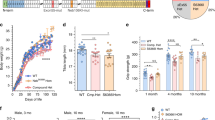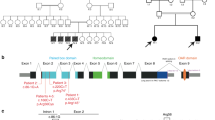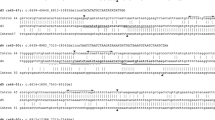Abstract
A locus for autosomal recessive nemaline myopathy (NEM2) has been assigned by linkage analysis to a 13-cM region between the markers D2S150 and D2S142 on 2q21.2–q22. The genes for the giant muscle proteins nebulin and titin have previously been assigned by FISH to 2q24.1–q24.2 and 2q31, respectively. By using radiation hybrid mapping, we have reassigned the nebulin gene close to the microsatellite marker D2S2236 on 2q22 and the titin gene to the vicinity of the markers D2S384 and D2S364 on 2q24.3. The genomic orientation of the nebulin gene was determined as 5′-3′ and of TTN as 3′–5′ from the centromere. We conclude that the nebulin gene resides within the candidate region for NEM2 on the long arm of chromosome 2, while the titin gene is located outside this region.
Similar content being viewed by others
Introduction
The nemaline myopathies are muscle disorders characterised by muscle weakness and hypotonia, and histologically by the presence in the muscle fibres of threadlike nemaline bodies composed mainly of α-actinin and actin [1]. The mode of inheritance is either autosomal recessive or autosomal dominant. An autosomal dominant form of nemaline myopathy is caused by a mutation in the α-tropomyosin gene TPM3 residing on chromosome 1 [2]. An autosomal recessive form of nemaline myopathy (NEM2) has been assigned by genetic linkage analysis to a 13-cM region between the markers D2S150 and D2S142 on 2q21.2–q22 [3].
Whole-genome radiation hybrid (RH) panels, constructed by the fusion of irradiated diploid human fibroblasts and recipient hamster cells, are efficient tools for gene mapping. Each independent RH clone retains between 15 and 20% of the human genome, as rearranged chromosomes of human origin and as human chromosome fragments integrated into hamster chromosomes [4]. This stable retention of random fragments of human chromosomes in the absence of selection provides the basis for RH mapping [5].
RH mapping has proven to be useful for determining both the order of genetic loci and distances between them. The results obtained by RH mapping and other mapping methods, i.e. FISH and pulse-field gel electrophoresis, have been found to be in good agreement with each other [6].
The genes for the giant muscle proteins nebulin and titin have previously been assigned by FISH to chromosomes 2q24.1–q24.2 and 2q31, respectively [7]. In apparent conflict with this, recent RH data place the titin gene in a 7-cM region between markers D2S382 and D2S335 on 2q23 [8].
We have used two different RH panels to refine the localisation of the genes for nebulin and titin in order to include or exclude them as candidate genes for NEM2. EVX2, a homeobox gene related to the Drosophila-even-skipped gene, was included in the study since it has been localised near the titin gene on 2q31 [7].
Materials and Methods
RH Panels
The Whitehead Institute Genebridge4 [8] and the Stanford Human Genome Center G3 [5] RH panels were used in the study. Both panels were purchased from Research Genetics (Huntsville, Ala., USA). The Genebridge4 RH panel consists of 93 hybrids constructed by irradiating human fibroblasts with 3,000 rad [8]. The Stanford G3 RH panel consists of 83 hybrids, and the x-ray dose used in the construction of the panel was higher, i.e. 8,000–10,000 rad, making it useful for determining the order of more closely located markers [5]. The map positions of sequence-tagged sites (STS) screened in RH panels are expressed in centirays (cR); 1 cR3,000 corresponds to a 1 % frequency of breakage between two markers after exposure to 3,000 rad of x-rays [4]. For chromosome 2,1 cR3,000 corresponds to a physical distance of approximately 225 kb [8].
DNA Primers
For nebulin, three primer pairs were used to localise the nebulin gene; one primer pair (NEB3′UTR) amplified a 339-bp fragment from the 3′ untranslated region of nebulin (bp 20,461–20,800, EMBL data library AC X83957). The second primer pair (NEB-AC) was derived from an intron, which was identified during the search for potential polymorphic markers. This intron sequence contains a non-polymorphic (AC)14 repeat and is located within the central differentially spliced region of the nebulin gene. The third primer pair (NEB5′) amplified a 154-bp sequence from within the first 500 bp of the nebulin 5′ coding region. For titin, also we used two primer pairs to localise the gene; one primer pair (TTN3′, WI-9271) amplified a 114-bp fragment from the 3′ untranslated region of titin (bp 14,569–14,683, gene-bank AC X69490). The second primer pair (TTN5′) is from an intron located near the 5′ end of the titin gene. Information on the nebulin and titin primer pairs and the PCR conditions used is available under https://doi.org/www.embl-heidelberg.de/ExternalInfo/Titin/. The EVX2 primers EVX2F1:5′-GTATCAATTCCAGTGCATGCCTG-3′ and EVX2R1:5′-CGTGTTCCCAGCTCGTGTCC-3′ were chosen from the sequence for the EVX2 intron (Genbank M59983) since the intron was stated to be smaller in mouse than human [9], providing the likelihood of differentiating the human gene on rodent backgrounds. Fifteen known microsatellite markers [10] spanning a 67-cM region on chromosome 2q22–q33 were included in the study.
PCR Analysis
Standard PCR procedures were applied for the determination of the presence or absence of the selected chromosome 2 markers in the RH panels. The annealing temperature was 55°C for all markers except D2S364 (54°C), GCT16H02 (56°C), WI-2531 (56°C), NEB-AC (56°C), NEB3′UTR (58°C) and TTN5′ (58°C). The PCR reactions were performed using DynaZyme™ DNA polymerase (Finnzymes Oy, Espoo, Finland) for amplification in a reaction volume of 10 µl including 25 or 50 ng RH DNA. PCR amplification of the EVX2 STS was performed using 5 units Amplitaq (Perkin-Elmer), using the supplied buffer for 40 cycles at 60°C annealing temperature. Each RH was scored for the presence or absence of the markers by visual assessment of PCR-amplified DNA in ethidium-bromide-stained agarose gels. The TTN3′ PCR products were analysed in silver-stained Polyacrylamide gels in order to distinguish the human products from the hamster background. Each marker was assessed at least twice in the RH panels.
Analysis of RH Data
The screening results for the Genebridge4 panel were analysed using the automated mapping service at the Whitehead Institute/MIT Center for Genome Research RH server at the web site https://doi.org/www-genome.wi.mit.edu/. As recommended in the instructions, the lod score for linkage to the framework map was selected as 15. The mapping results are based on the screened STS positioned on the RH framework maps and give estimates in cR of the distance from the closest framework marker to the marker under study. Similarly, the results from the Stanford G3 panel were analysed on the RH server at the Stanford Human Genome Center at the web site https://doi.org/www-shgc.stanford.edu/. As the mapping services did not give assignments for all markers under study, a stepwise ordering of the markers based on the observed RH positivity pattern was also done.
Results
The Whitehead Insitute RH automated mapping service gave map positions for 14 of the 21 STS screened in the Genebridge4 RH panel (table 1, fig. 1). The map positions of the markers are expressed as cR from the top of the chromosome 2 linkage group. The automated mapping service gave an assignment for NEB5′ and NEB3′UTR, but not for NEB-AC on the basis of our screening data. NEB5′ was localised 795 cR from the top of the chromosome 2 linkage group. NEB3′UTR was localised 0 cR from the Whitehead framework marker WI-4798, i.e. 796 cR from the top of the chromosome 2 linkage group. We obtained the same localisation (796 cR) for the microsatellite marker D2S2236 (table 1, fig. 1), placing nebulin very close to this marker. According to these results, the genomic orientation of the nebulin gene is centromere-5′-3′-telomere. The closest microsatellite marker on the distal side of nebulin is D2S356, which was localised 810 cR from the top of chromosome 2 (table 1, fig. 1). The order of the markers for which the automated mapping service was unable to give a localisation was deduced from the RH positivity pattern and is shown in table 2.
For titin, the TTN3′ marker was placed 892 cR and the TTN5′ marker 899 cR from the top of the chromosome 2 linkage group. According to these results, the genomic orientation of the titin gene is centromere-3′–5′-telomere. The closest microsatellite markers, D2S384 and D2S364, were placed 894 and 910 cR from the top of the chromosome 2 linkage group, respectively. The localisation for EVX2 was 897 cR from the top of chromosome 2 in the Genebridge4 panel (table 1, fig. 1) and close to D2S2314 (between the markers D2S335 and D2S300) in the Stanford G3 panel (table 3).
The results from the Stanford G3 RH panel are shown in table 3. Thirty-six of the 83 RH were positive for at least one of the markers tested. On the basis of these results it is possible to deduce the order of the markers and the localisation of the nebulin gene, which indeed appears to be between the markers D2S2236 and D2S356. The Stanford automated mapping service was able to localise the markers D2S132, D2S381, D2S151, D2S298, D2S2277 and EVX2 on the basis of our screening results. The order of the markers is shown in table 3.
Discussion
Nebulin is a filamentous protein expressed exclusively in vertebrate striated muscle. The full-length cDNA is 20.8 kb and predicts a molecular weight of about 800 kD for the protein. The upper limit for the size of the genomic region comprising the nebulin gene has been assessed as 400 kb [11]. Nebulin is mainly composed of small repeats, about 35 amino acids long, which interact with actin. Seven small repeats are assembled to form a super-repeat [12]. The correlation of its size with thin filament lengths in vertebrates suggests that nebulin may function as a molecular ruler to determine thin filament length. Furthermore, it has been proposed that different types of nebulin molecular rulers are expressed in the different types of skeletal muscles by differential splicing [11].
The other giant muscle protein, titin, has a cDNA of 82 kb and a predicted molecular weight of 2,993 kD. Ninety percent of the mass is contained in a repetitive structure composed of 244 copies of 100-residue repeats. The titin gene appears to span about 300 kb of genomic DNA. Similarly to nebulin, variable-length versions of titin are expressed as the result of differential splicing. Since both nebulin and titin are present in thin filaments, correct assembly of the I-band seems to require co-ordinated splicing of the titin and nebulin precursor mRNA [13].
Our results refine the localisation of the genes for nebulin and titin on the long arm of chromosome 2. The nebulin gene is located in the vicinity of the microsatellite marker D2S2236 in a 5′ to 3′ orientation from the centromere. The marker D2S356 is located 14cR distal of D2S2236. The ratio between physical and breakage distance has been reported as 225 kb/cR3,000 for chromosome 2 [8]. Accordingly, the 14-cR region between the markers D2S2236 and D2S356 would correspond to 3,150 kb. The markers D2S2236 and D2S356 can be tentatively assigned to 2q22 [14].
Titin is located in the vicinity of the microsatellite markers D2S384 and D2S364, in a 3′–5′ orientation from the centromere. The markers D2S384 and D2S364 can be tentatively assigned to 2q24.3 [14]. Our RH map localisation of titin is not in complete agreement with that of Gyapay et al. [8] (titin between markers D2S382 and D2S335), as D2S384 and D2S364 are situated distal to the region limited by D2S382 and D2S335 on the genetic linkage map. Furthermore, our RH data indicate that D2S384 and D2S364 are located distal of D2S335. On the other hand, the human gene map launched by Science in October 1996 [available at https://doi.org/ncbi.nlm.nih.gov/Science96/] contains five different titin expressed STS located close to the marker D2S324 (at 887 cR from the top of the chromosome 2 linkage group), which is in agreement with our results.
The EVX2 STS was placed between D2S384 and D2S364 in the Genebridge4 panel, 2 cR from TIN5′. A slightly different localisation was obtained in the Stanford G3 panel, where EVX2 was placed near D2S2314, which is 1 cM centromeric of D2S300. According to D’Esposito et al. [9], EVX2 is located a few kilobase pairs upstream of the HOXD locus, which is centromeric to titin. On the human gene map [https://doi.org/ncbi.nlm.nih.gov/Science96/], one of the HOXD genes is placed between the markers D2S335 and D2S385, i.e. in the same region as our localisation for EVX2.
Although our localisation of nebulin, titin and EVX2 appears more proximal than the FISH results of Rossi et al. [7], our data on the distance between the nebulin gene, EVX2 and the titin gene and the order of them seem to be in good agreement with their results.
Three of the markers we used (D2S151, D2S356, D2S118) have been localised previously by RH mapping and are included on the RH map available from the Whitehead Institute [https://doi.org/www-genome.wi.mit.edu/]. Our results are in good agreement with the Whitehead data, except for the marker D2S356, for which a 16-cR (3.6 Mb) difference in mapping position was obtained. Our localisation of D2S356 is, however, based on a linkage odds ratio of 1,000:1, whereas D2S356 is positioned on the RH map with an odds ratio of less than 10:1. The results obtained in the G3 RH panel also support a localisation of D2S356 between the markers D2S2236 and D2S321 (table 3). D2S356 is placed between the markers D2S2277 and D2S2275 on the Généthon genetic linkage map [available at https://doi.org/www.genethon.fr/]. The results regarding the localisation of the microsatellite markers in the Genebridge4 and the G3 RH panels, with the exception of D2S356, are in good agreement with the genetic linkage map (table 1).
By using RH mapping, we have assigned the nebulin gene close to the microsatellite marker D2S2236 on chromosome 2q22 and the titin gene in the vicinity of the markers D2S384 and D2S364 on 2q24.3. Thus, the nebulin gene resides within the candidate region for NEM2, while the titin gene seems to be located outside this region. Therefore, we have initiated a search for mutations in the nebulin gene of affected persons. Identification of the faulty gene may provide insights into the molecular nature of rod formation and the cause of muscle weakness in nemaline myopathy.
References
Dubowitz V: Muscle Disorders in Childhood, ed 2. London, Saunders, 1995, pp 147–155.
Laing NG, Wilton SD, Akkari PA, Dorosz S, Boundy K, Kneebone C, Blumbergs P, White S, Watkins H, Love DR, Haan E: A mutation in the a tropomyosin gene TPM3 associated with autosomal dominant nemaline myopathy. Nat Genet 1995;9:75–79.
Wallgren-Pettersson C, Avela K, Marchand S, Kolehmainen J, Tahvanainen E, Juul Hansen F, Muntoni F, Dubowitz V, de Visser M, Van Langen IM, Laing NG, Fauré S, de la Chapelle A: A gene for autosomal recessive nemaline myopathy assigned to chromosome 2q by linkage analysis. Neuromusc Disord 1995;5:441–443.
Walter MA, Spillett DJ, Thomas P, Weissenbach J, Goodfellow PN: A method for constructing radiation hybrid maps of whole genomes. Nat Genet 1994;7:22–28.
Cox DR: Mapping with radiation hybrids. Genome Digest 1995;4:14–15.
Warrington JA, Bengtsson U: High-resolution physical mapping of human 5q31–q33 using three methods: Radiation hybrid mapping, interphase fluorescence in situ hybridization, and pulsed-field gel electrophoresis. Genomics 1994;24:395–398.
Rossi E, Faiella A, Zeviani M, Labeit S, Floridia G, Brunelli S, Cammarata M, Boncinelli E, Zuffardi O: Order of six loci at 2q24–q31 and orientation of the HOXD locus. Genomics 1994;24:34–40.
Gyapay G, Schmitt K, Fizames C, Jones H, Vega-Czarny N, Spillett D, Muselet D, Prud’Homme J-F, Dib C, Auffray C, Morissette J, Weissenbach J, Goodfellow PN: A radiation hybrid map of the human genome. Hum Mol Genet 1996;5:339–346.
D’Esposito M, Morelli F, Acampora D, Migliacco E, Simeone A, Boncinelli E: EVX2, a human homeobox gene homologous to the even-skipped segmentation gene, is localized at the 5′ end of the HOX4 locus on chromosome 2. Genomics 1991;10:43–50.
Dib C, Fauré S, Fizames C, Samson D, Drouot N, Vignal A, Millasseau P, Marc S, Hazan J, Seboun E, Lathrop M, Gyapay G, Morissette J, Weissenbach J: A comprehensive genetic map of the human genome based on 5,264 microsatellites. Nature 1996;14:152–154.
Labeit S, Kolmerer B: The complete primary structure of human nebulin and its correlation to muscle structure. J Mol Biol 1995;248:308–315.
Pfuhl M, Winder SJ, Pastore A: Nebulin, a helical actin binding protein. EMBO J 1994;13: 1782–1789.
Labeit S, Kolmerer B: Titins: Giant proteins in charge of muscle ultrastructure and elasticity. Science 1995;270:293–296.
Cox S, Bryant SP, Collins A, Weissenbach J, Donis-Keller H, Koeleman A, Steinkasserer BP, Spurr NK: Integrated genetic map of human chromosome 2. Ann Hum Genet 1995;59: 413–434.
Acknowledgements
We thank Lori Blechynden for assistance and designing of the EVX2 primers. We are grateful to the Association Française contre les Myopathies, France, the Finska Läkaresällskapet, Finland, the Australian National Health and Medical Research Council (grants 940122 and 970104), Australia, and to the Deutsche Forschungsgemeinschaft (grant La668/3-2), Germany, for financial support and to the European Neuromuscular Centre for organisational support.
Author information
Authors and Affiliations
Corresponding author
Rights and permissions
About this article
Cite this article
Pelin, K., Ridanpää, M., Donner, K. et al. Refined Localisation of the Genes for Nebulin and Titin on Chromosome 2q Allows the Assignment of Nebulin as a Candidate Gene for Autosomal Recessive Nemaline Myopathy. Eur J Hum Genet 5, 229–234 (1997). https://doi.org/10.1007/BF03405922
Received:
Revised:
Accepted:
Issue Date:
DOI: https://doi.org/10.1007/BF03405922




